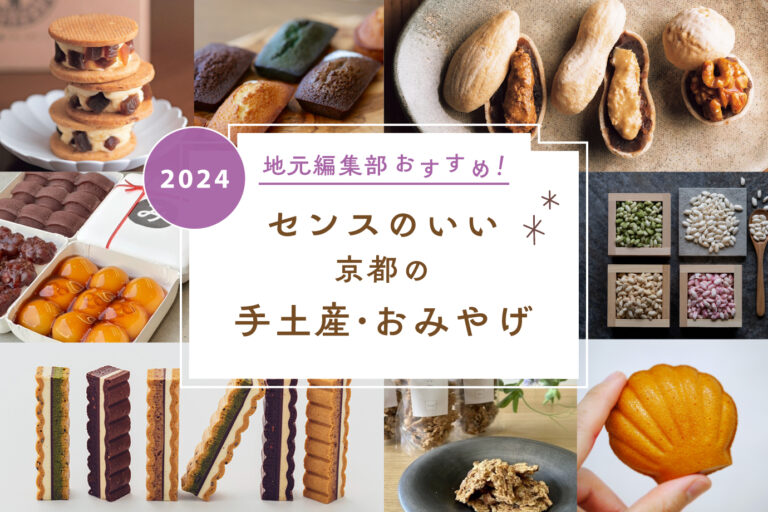
[2024] Selected by Leaf editors! Kyoto with good taste...
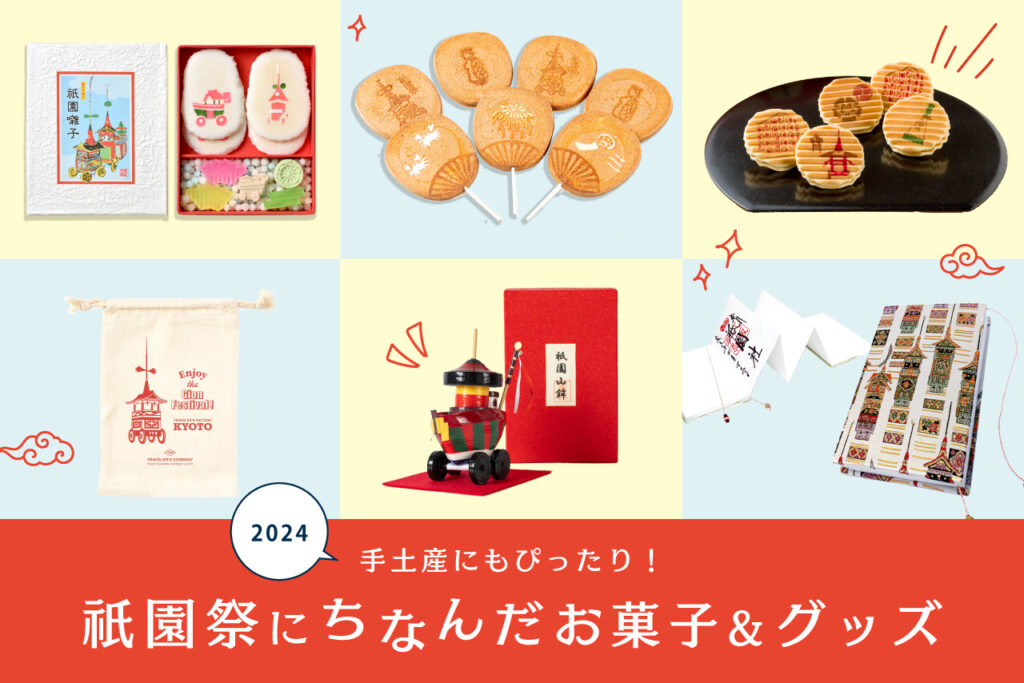

When the sound of "Konchikichin" begins to echo, the streets of Kyoto are filled with the Gion Festival. Here, we introduce a selection of limited-edition goods such as sweets and Japanese accessories associated with the Gion Festival. Wagashi in the shape of zongzi (dough cake wrapped in bamboo leaves) or hoko (wooden halberds) will also be available to add a festive touch to the festival. Get your hands on a special souvenir that will bring back memories of summer in Kyoto.
(TEXT / Yurie Sano)
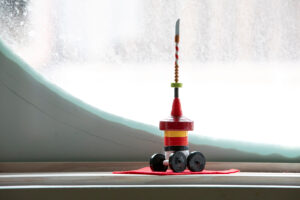
Kyokoma Jakyokyu Kyokoma Gion Yamaboko (Photo: Nagatohoko)
3,850 yen (tax included, shipping fee not included)
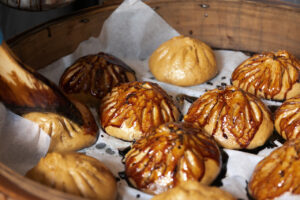
Set of 6 Shimidare pork buns
3,000 yen (tax and shipping not included)
Founded in 1803 in Nishijin, Kyoto, Tsuruya Yoshinobu (Kamigyo-ku, Kyoto City, Kyoto Prefecture) is a Kyoto confectioner that has preserved traditional techniques while inventing new ideas for Japanese confections that incorporate modern sensibilities. Konchichin is a baked confectionary named after the musical accompaniment that can be heard throughout the city during the Gion Festival. The baked crust is made from a combination of wheat and rice flours, with a special Ogura-an (sweet bean paste) filling sandwiched in between. The new package, which comes in a drawstring, depicts a scene from the Gion Festival, making it a perfect souvenir.
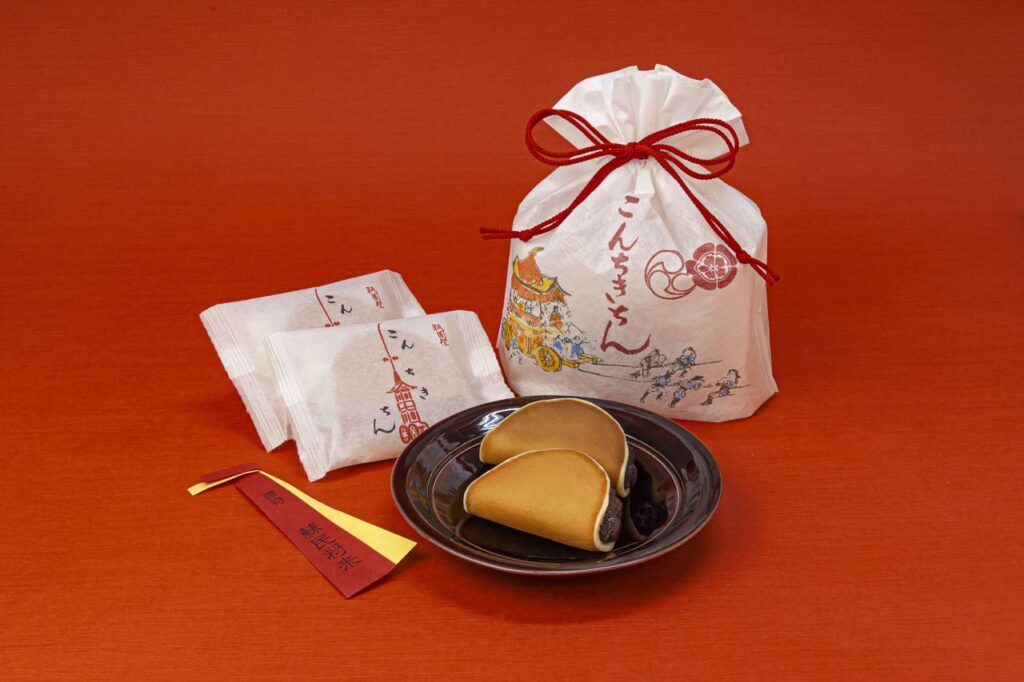
Konchikichin: 1,350 yen for 5 pieces in a drawstring bag, 238 yen for each piece sold separately. Also available in a boxed assortment from Monday, July 1 to late July.

Uji Sencha Gion and Mizudashi Sencha Gion are seasonal products from Fukujuen, a tea shop established in 1790 (Shimogyo-ku, Kyoto City, Kyoto Prefecture). The packaging features a design of a summer scene in Kyoto depicted in the "Gion Matsuri Matsuri Zu Byobu" (a folding screen depicting the Gion Festival). The Uji Sencha Gion has a moderate astringency and rich flavor, while the mizudashi Sencha Gion offers a robust tea flavor and freshness even when brewed with water. The Kyoto Main Store is a facility where visitors can experience Kyoto's dynastic culture and the world of Uji tea, and a variety of encounters with tea await, including a tea-making experience and a matcha experience in a tea room.
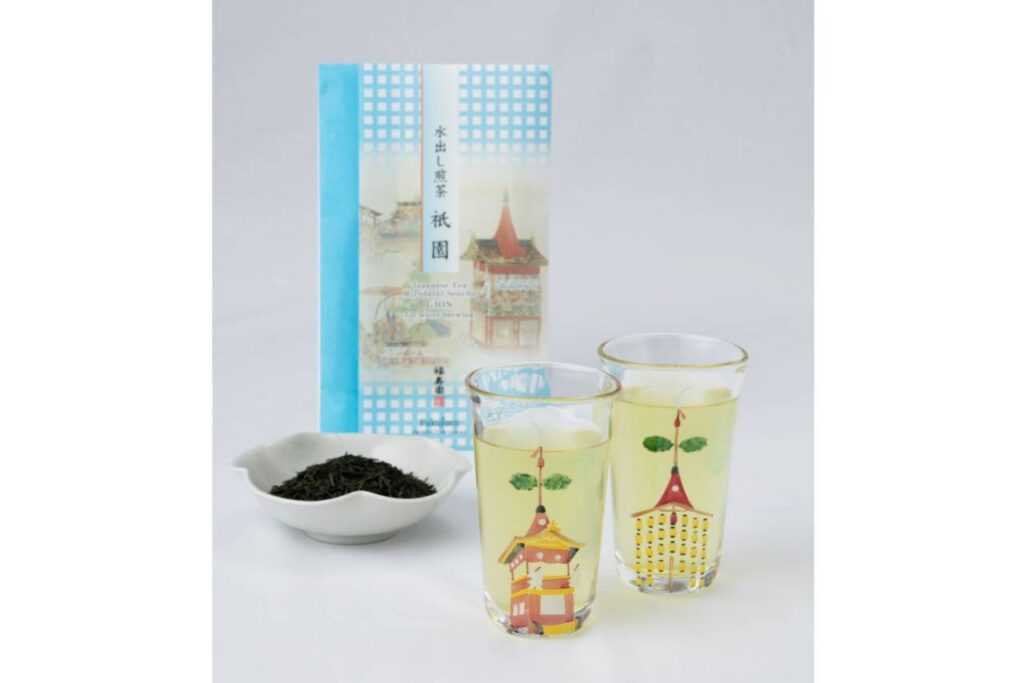
Photo shows mizudashi sencha Gion, 1080 yen; to be sold from around late June to the end of July *Uji sencha Gion is also available for 1080 yen

This year, too, the long-established Kyoto sweets store Sasaya Iori (Shimogyo-ku, Kyoto), which has been in business for more than 300 years, is offering a limited edition wagashi for the Gion Festival. This elegant confection is made with chewy dough wrapped in gyuhi and branded with the Yasaka Shrine's sacred crests of Tomoe and Kikuri. This product will be sold at all stores in Kyoto, so if you cannot enjoy the Gion Festival in person, be sure to check out a store near you.
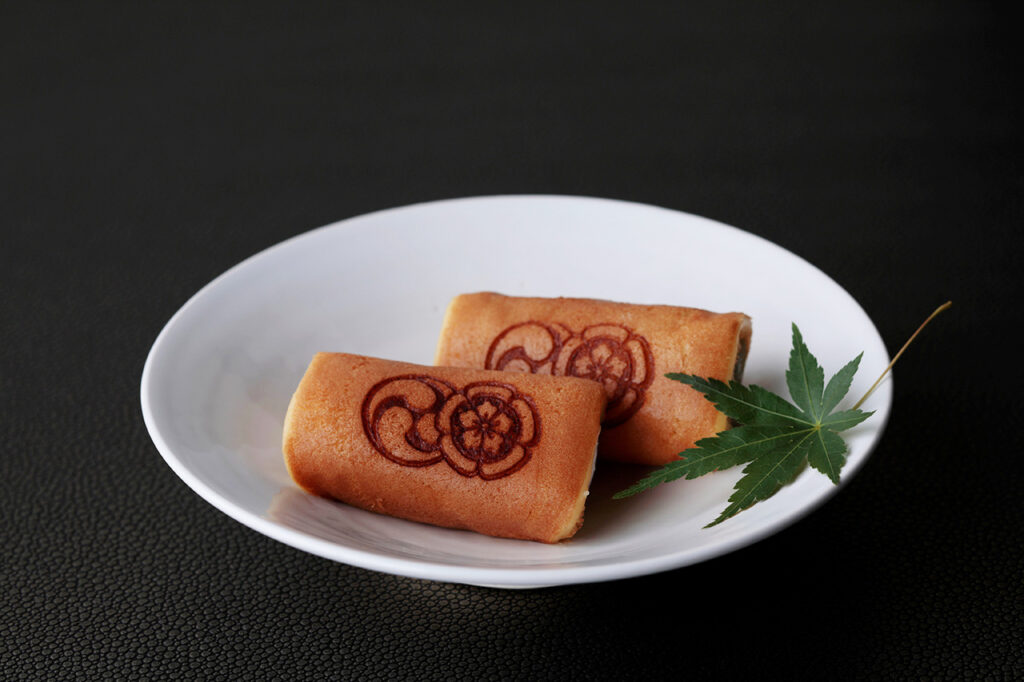
Ancient Capital Festival: 1,296 yen for 5 pieces. Sold from July 13 (Sat.) to 16 (Tue.) (End when sold out)

[KAMEYA RYOCHO (Shimogyo-ku, Kyoto City, Kyoto Prefecture) is a Kyoto confectionary store that is known for its products with a modern flair. The sliced Yokan (sweet bean curd), which was created by a revolutionary idea, is one of the company's most popular Japanese sweets. Yoiyama Dango (dumplings for the Gion Festival) heralds the arrival of the Gion Festival season. These dumplings are filled with white miso paste and wrapped in gyuhi, giving them an irresistible chewy texture. The dumplings are about the size of a bite, so you may find yourself reaching for another one as you eat them. Inside the box, the dumplings are lined up like the lanterns of the Yamahoko floats, which conveys the atmosphere of the Gion Festival. The sales period is a little short, so be sure to check the information before buying.
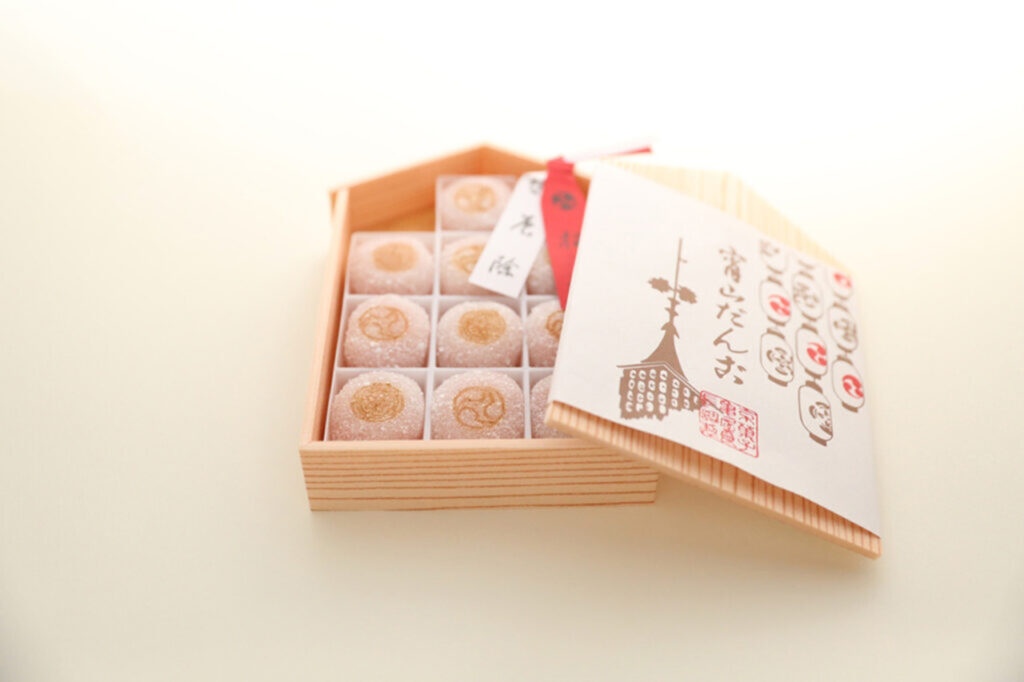
Yoiyama Dango: 1,620 yen, available from July 10 (Wed.) to 16 (Tue.) (ends when sold out)

Tawaraya Yoshitomi (Kamigyo-ku, Kyoto City, Kyoto Prefecture) has been making traditional Kyoto sweets since its establishment in the Edo period. The Gion Hayashi, a limited edition product sold in July, is one of the creative dry confections in the series. The fuyaki decorated with the floats and the colorful dried amber are so gorgeous that it would be a shame to eat them. You can almost hear the music of the Gion Festival from the box of dried confections. These sweets are not only to be tasted, but also to be enjoyed as a work of art.
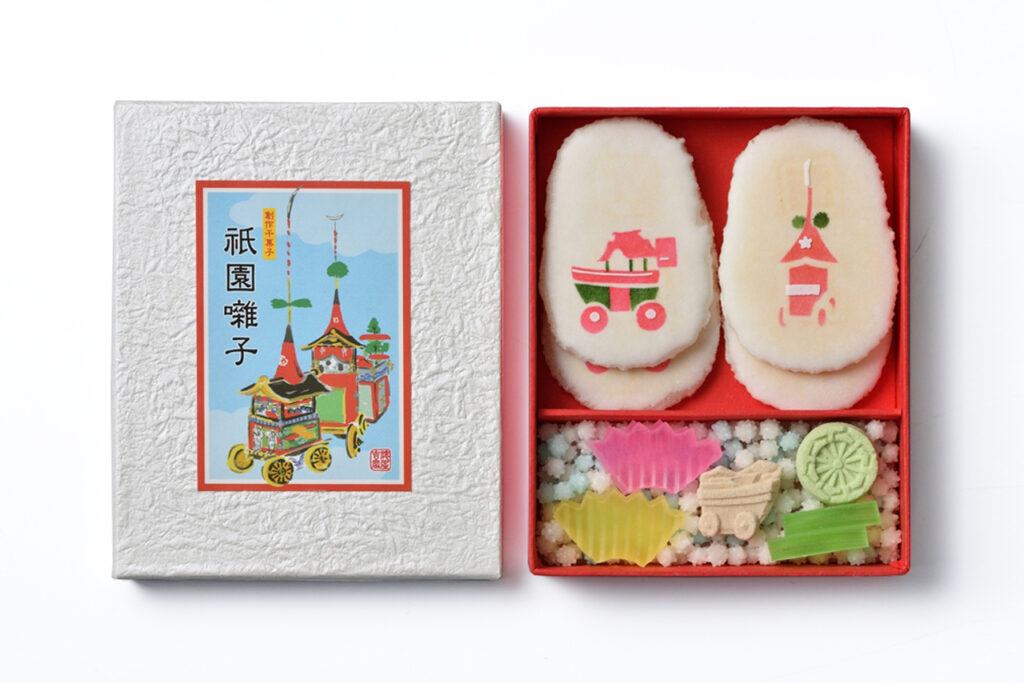
Gionbayashi: 1080 yen; available from around July 1 (Mon.) to 24 (Wed.)

Shogoin Yatsuhashi Sohonten (Sakyo-ku, Kyoto), established in 1689, has been making Japanese sweets that have been loved for a long time under the slogan "Taste is tradition. The popular Sei (meaning "holy" in Japanese), which is made by wrapping fresh yatsuhashi with Nikki and matcha green tea in a sweet bean paste cooked in-house, is now available in a Gion Festival version for July only. On the back of the package depicting the Yamaboko floats, there is a map showing the location of the floats, which will help you enjoy the Gion Festival to the fullest.
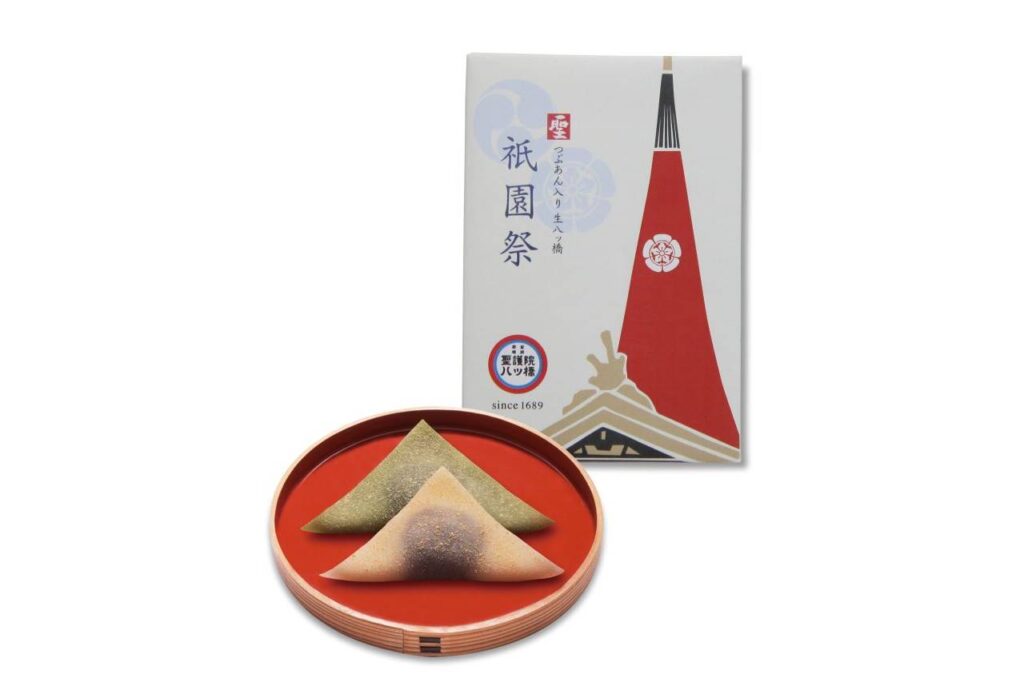
St. Gion Festival 680 yen. sold from Monday, July 1 to late July.

Founded in the Meiji era (1868-1912), Narumi Mochi Honten (Kamigyo-ku, Kyoto City, Kyoto Prefecture) has a nearly 150-year history. The shop sells products that are part of the Kyoto lifestyle, including its famous sekihan (red rice). The "Hoko Dorayaki" (float-shaped dorayaki) is a specialty of Narumi Mochi Honten during the Gion Matsuri (Gion Festival) season. The branding on the dorayaki is a symbolic representation of the Choto-boko (long sword), making it easy to tell at a glance that it is a confectionery associated with the Gion Matsuri Festival. The key to the flavor is the moist and fluffy dough made by hand and the red bean paste made from Dainagon Azuki produced in Tanba. Buy one for the number of friends or family members you have.
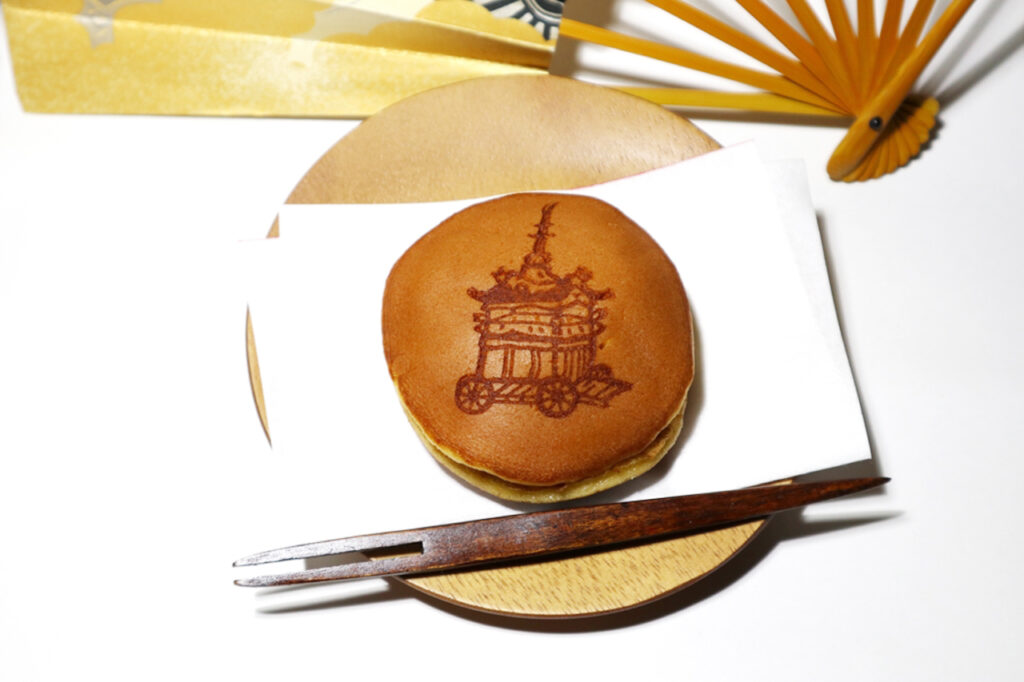
Hoko Dorayaki: 227 yen; sold from Monday, July 1 to around Wednesday, July 24

[Kyo-Agetsu (Sakyo-ku, Kyoto City, Kyoto Prefecture) is a long-established confectionery shop founded in the Edo period. They offer sweets that incorporate the four seasons, and Choto Chimaki is one of them. When you open the package, which is designed in the image of the Nagatohoko float of the Gion Festival, you will find six freshly made bite-sized chimaki with the aroma of bamboo grass. There are three each of the green tea and azuki bean paste flavors in the package, so you can enjoy the different flavors. Chimaki is a type of zongzi that is indispensable for the Gion Festival to ward off bad luck. It would be a good idea to buy these as "edible chimakis.
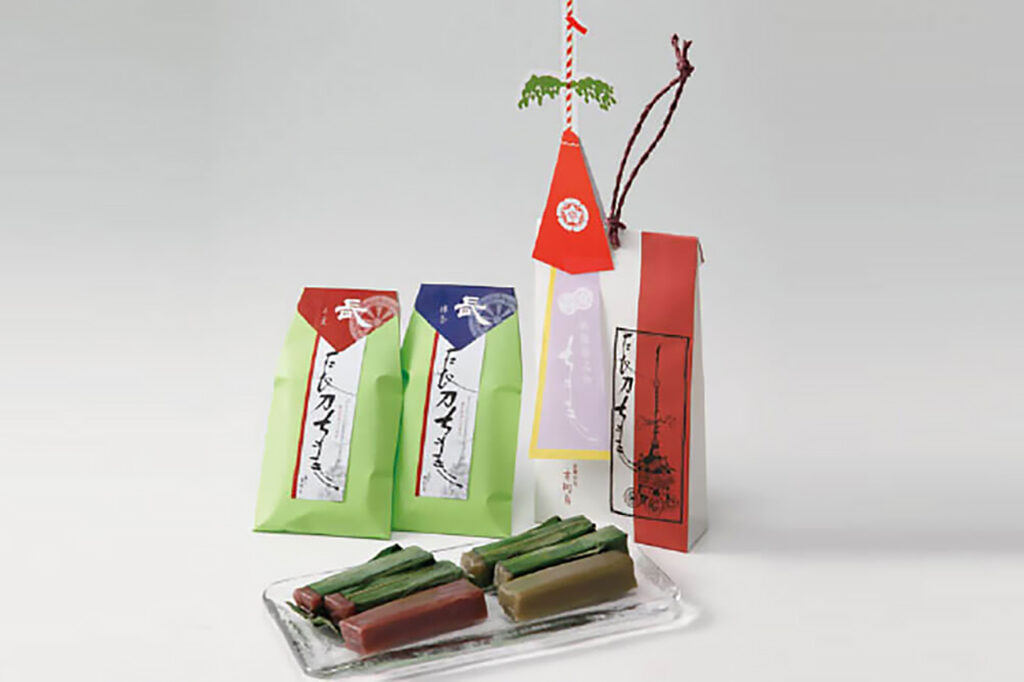
Choto Chimaki: 1080 yen for 6 pieces, available from July 1 (Mon.) to 31 (Wed.)

Sanjyo Wakasaya (Nakagyo-ku, Kyoto City, Kyoto Prefecture) is located at the easternmost end of the Sanjokai shopping district. The Gion Chigo Mochi, their signature product, is introduced here. The story goes that the second-generation owner created the mochi in the Taisho era (1912-1926) based on a rice cake that was once served at the Gion Festival to bring good luck and ward off disaster. The design of the package, which is decorated with strips of paper wrapped in the image of bamboo bark, is also reminiscent of the history that has been passed down through the generations. The rice cake is skewered on a bamboo skewer, which keeps your hands clean when eating. It is a famous confectionary of the Gion Festival that evokes a sense of nostalgia.
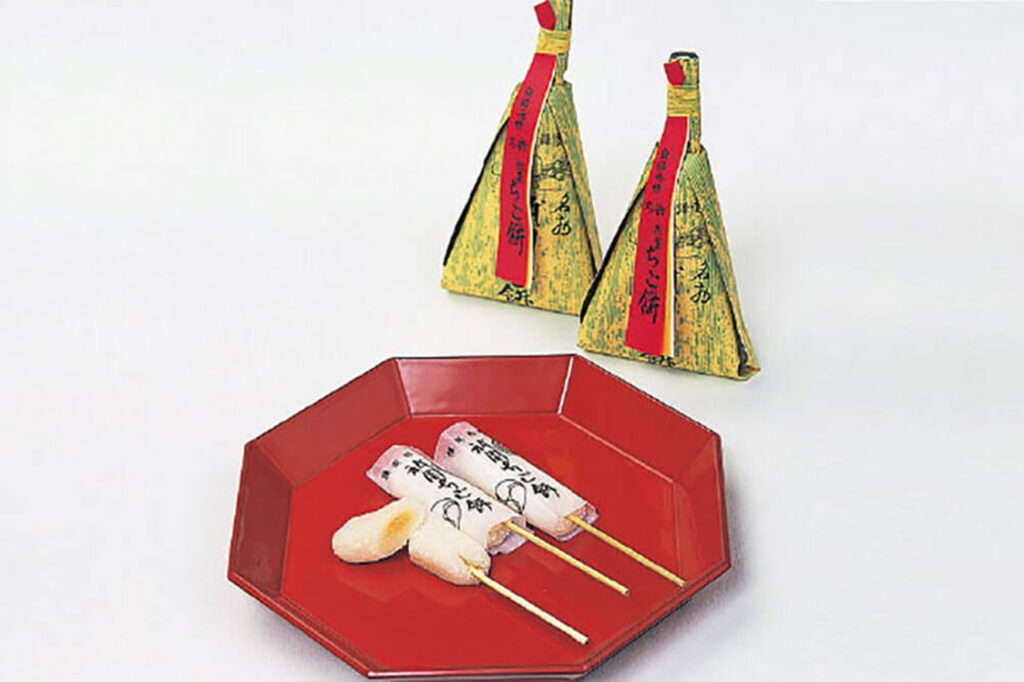
Gion Chigo Mochi 3pcs. 540 yen (sold all year round)

Kyo-Ame Crochet (Shimogyo-ku, Kyoto City, Kyoto Prefecture) is well known for its candy that combines the skills of Kyoto craftsmen with the beauty of European technology. Their colorful candies with Japanese designs are beautiful to look at and have many female fans. The Gion Yamaboko, featured in this issue, is a limited edition product available only during this time of the year, and will be in stores until around the end of July. The bright red and black color of this blackcurrant-flavored candy is eye-catching. The candy has a long shelf life of one year and is available in large quantities, so it is recommended to enjoy it a little at a time rather than eating it in a short period of time. If you enjoy it from time to time, it may remind you of the Gion Festival.
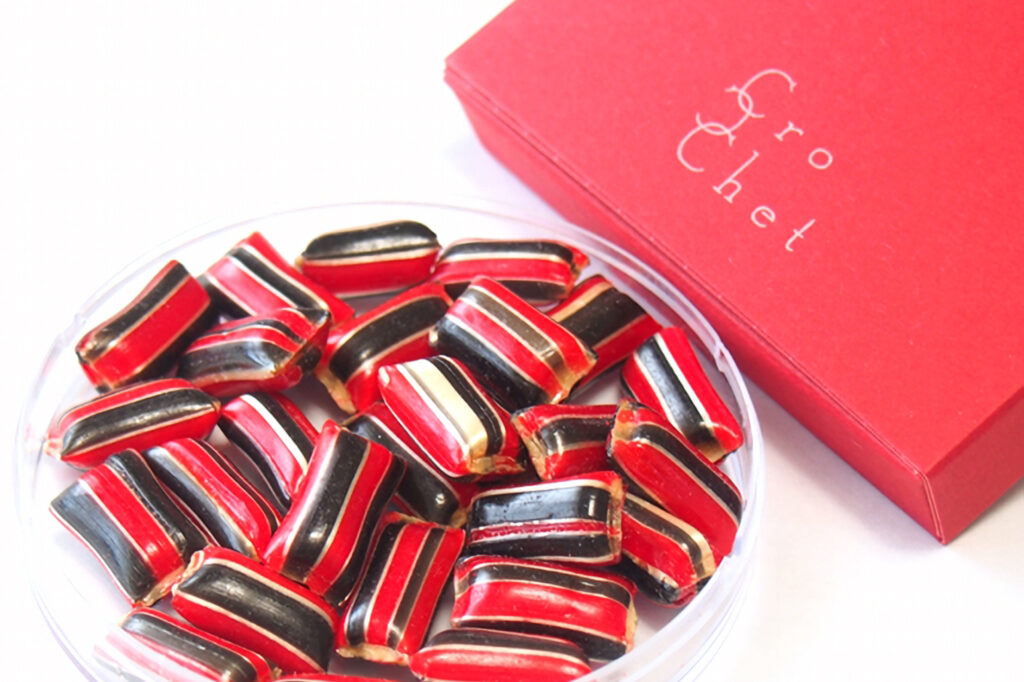
Gion Yamaboko 540 yen; sold until late July (ends when sold out)

[nikiniki" (Shimogyo-ku, Kyoto City, Kyoto Prefecture) was created by Shogoin Yatsuhashi Sohonten as a brand that proposes a new way of eating yatsuhashi. The popular seasonal fresh confections are fresh yatsuhashi decorated with flowers and events of the four seasons and filled with either koshi-an (sweet red bean paste) or shiro-an (white bean paste). Every July, a design featuring the Gion Festival is introduced. They look lovely and make great gifts. Since they are fresh confections, they should be tasted on the same day.

Seasonal fresh confections 324 yen each. Gion Festival motif design available from July 8 (Mon.) to 24 (Wed.).

Kurooba Knot Shijo Shinmachi Store (Nakagyo-ku, Kyoto), popular for its soft and chewy dorayaki, will be offering Gion Festival branded dorayaki only in July. In addition to the standard Shiawase Dorayaki, there are 25 flavors on standby, including Shiawase Dorayaki Gokkuri, which is a luxurious filling of mashed sweet bean paste and chestnut sweetened chestnuts, and Shiawase Dorayaki Hojicha Awa, a flavor of roasted green tea. Try your favorite flavor. The long-established hanko (stamp) store attached to the shop sells rubber stamps and other original goods depicting the Yamahoko floats of the Gion Matsuri festival.
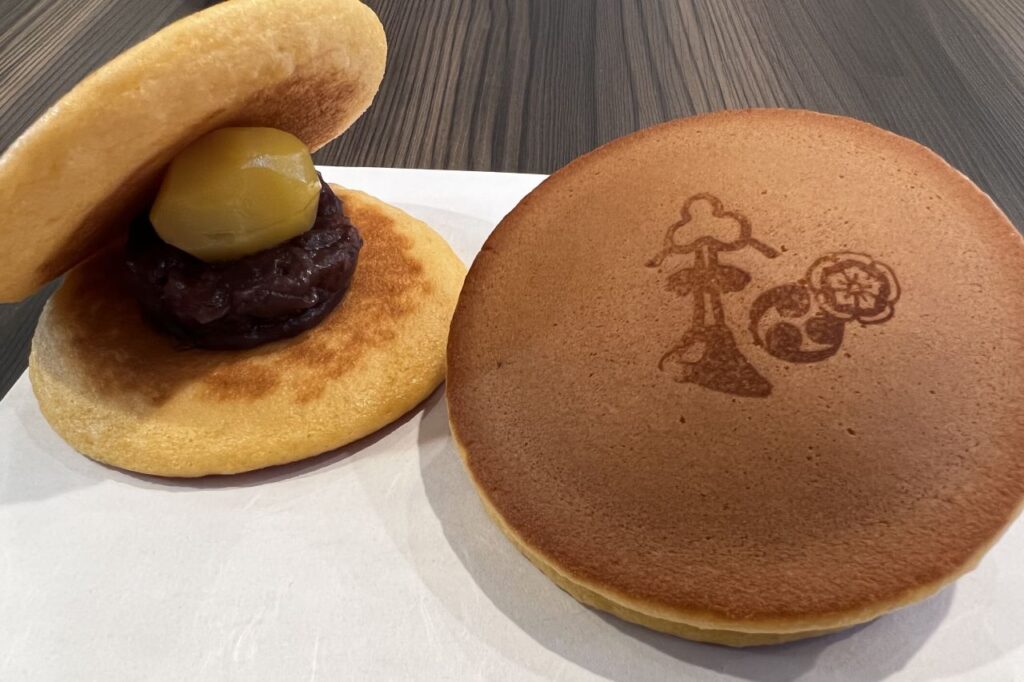
Shiawase Dorayaki (limited branding) 248 yen and up, available from Monday, June 24 to Wednesday, July 31

Since its establishment in 1922, Seki Seika Honpo (Tohei An) (Kita-ku, Kyoto City, Kyoto Prefecture) has been dedicated to making rice crackers. The confectionery is made with carefully selected ingredients and baked by hand by craftsmen. The summer product of note this season is the Miyako Uchiwa (Gion Festival), an egg rice cracker baked in the shape of an Uchiwa and branded with the Gion Festival's Hoko (float) and Maiko (apprentice geisha). From August, a new Miyako Uchiwa with a Gozan Okuribi (Bonfire of the Five Mountains) design will also be available.
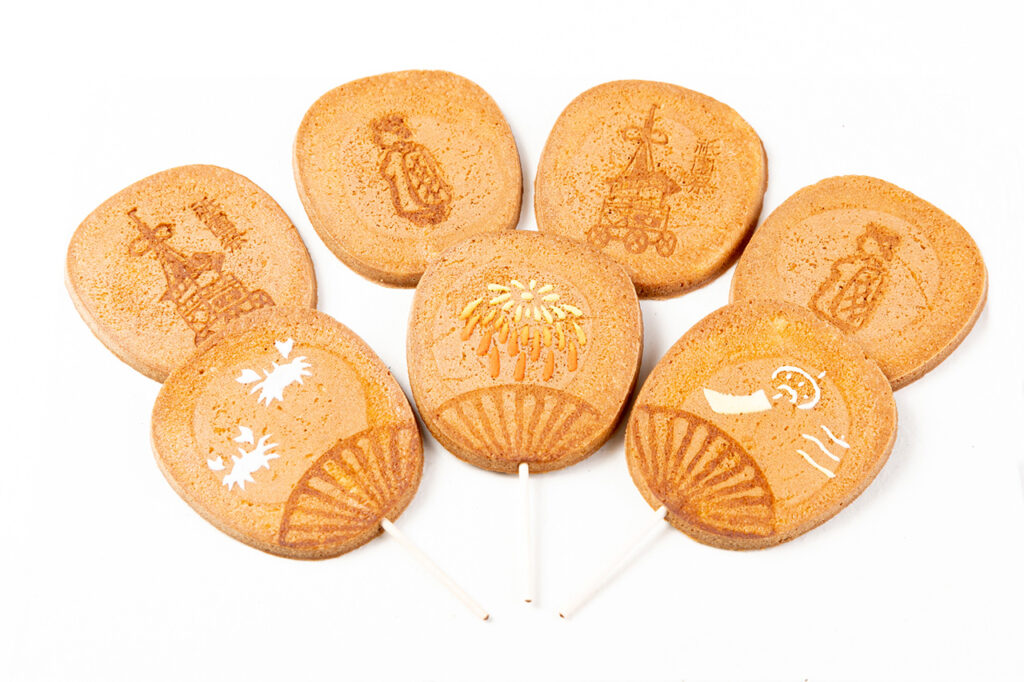
Miyako Uchiwa (Gion Festival): 518 yen for a pack of 7, 1101 yen for a pack of 15. Gion Matsuri design available until Wednesday, July 31.

Kogetsu (Nakagyo-ku, Kyoto City, Kyoto Prefecture), known for its senju senbei (rice crackers) with cream sandwiched between wave-shaped cookie dough, will introduce a new premium senju senbei in October 2022, made with carefully selected ingredients and with a richer, more aromatic taste than before. The Senju senbei with a Gion Festival design, which is limited to this time of year every year, will also be available in a premium senju senbei version for the first time this year. While admiring the illustrations of the lanterns and chimakis of the Yamaboko floats on the dough, it is also fun to reminisce about the Gion Matsuri Festival, which is associated with the design. The wrapping paper is also specially designed with Gion Festival motifs, and is recommended as a gift.
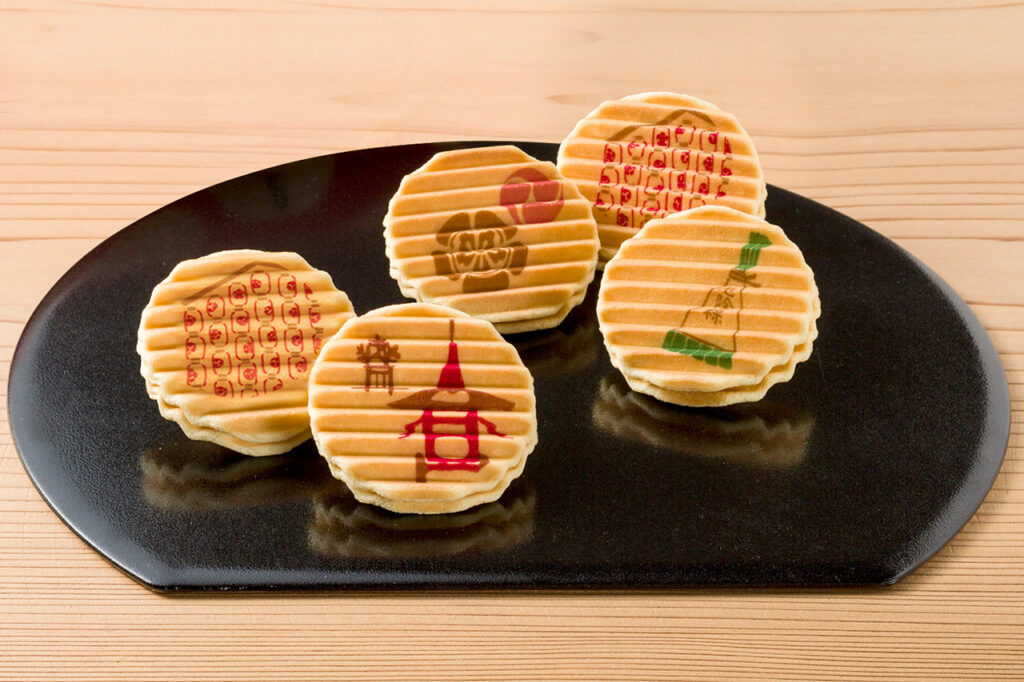
Design Premium Senju Senbei 8-packs, 1,944 yen, available from July 1 (Mon.) to July 31 (Wed.)

SOU-SOU Isegimen (Nakagyo-ku, Kyoto City, Kyoto Prefecture) sells Ise cotton dyed with Kyoto-style yuzen. Ise cotton, which has a long history of over 250 years, is appreciated by men and women of all ages as it becomes more textured and soft to the touch with each wash, making it a perfect gift. There is also a SOU-SOU Kimono store and other affiliated stores nearby that sell kimono, so be sure to check them out as well.
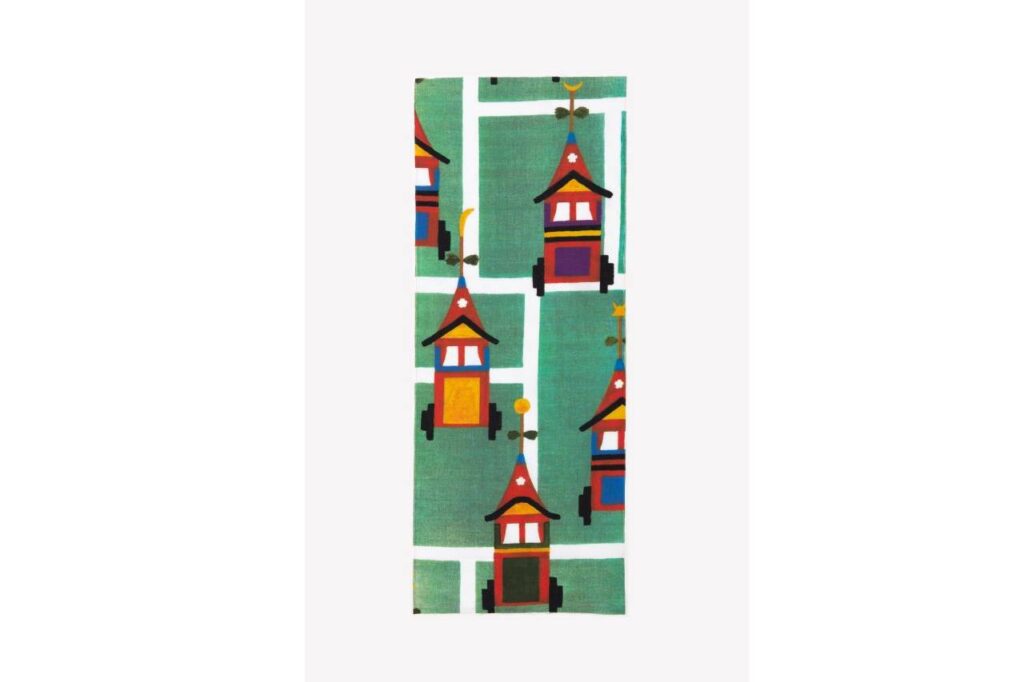
Ise cotton tenugui hand towel: Gion Festival: 1,380 yen. Sold all year round

Yamadamatsu Kogiten (Kamigyo-ku, Kyoto), located near the Kyoto Imperial Garden, is a long-established store specializing in fragrant woods founded in the mid-Edo period. The store sells fragrant woods, incense sticks, scent bags, and other items handcrafted by artisans. The shop is selling a beautifully designed red seal book with gold brocade decorated with the floats of the Gion Festival during the Gion Festival only. The set includes a bookmark with a gently scented sandalwood ball. Why not collect vermilion seals for each of the floats with this in hand?
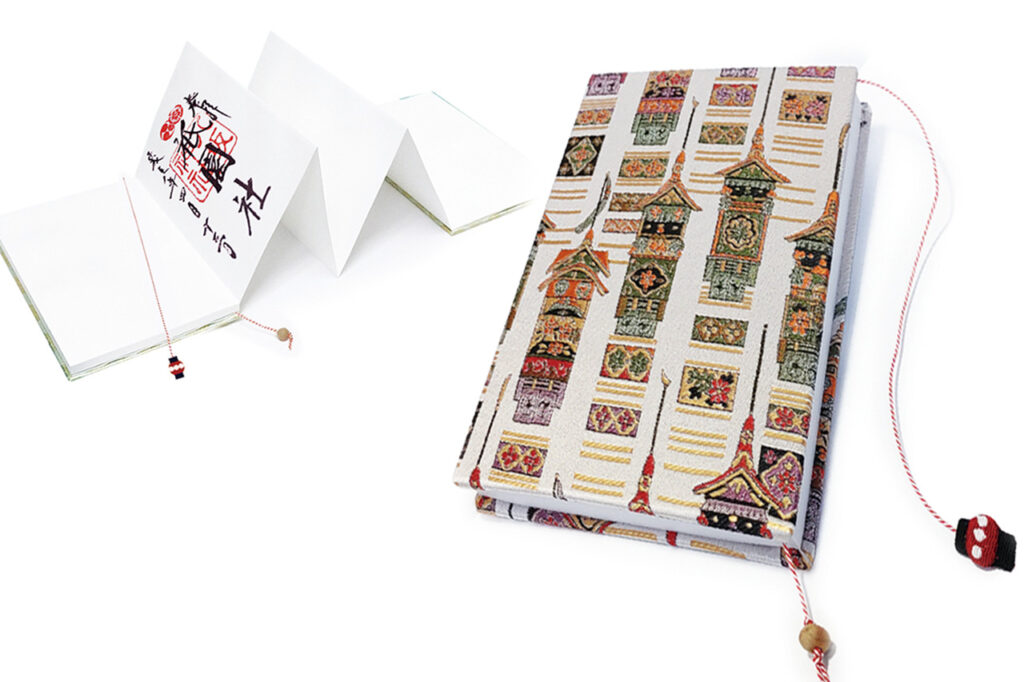
Gion Matsuri red seal book for 2,200 yen is available only in summer

Traveler's Factory Kyoto (Nakagyo-ku, Kyoto), located on the first floor of the popular Shinpukan building, is a stationery store centering on TRAVELER'S notebooks under the concept of "making travel more fun starting in Kyoto. In addition to notebook shopping, the shop also offers unique corners such as a customized stamp corner and a ticket scale. The cotton bag depicting the Gion Festival with a cool yet adorable touch is a drawstring type that can be easily matched with a yukata (light cotton kimono) and will come in handy while walking around Kyoto.
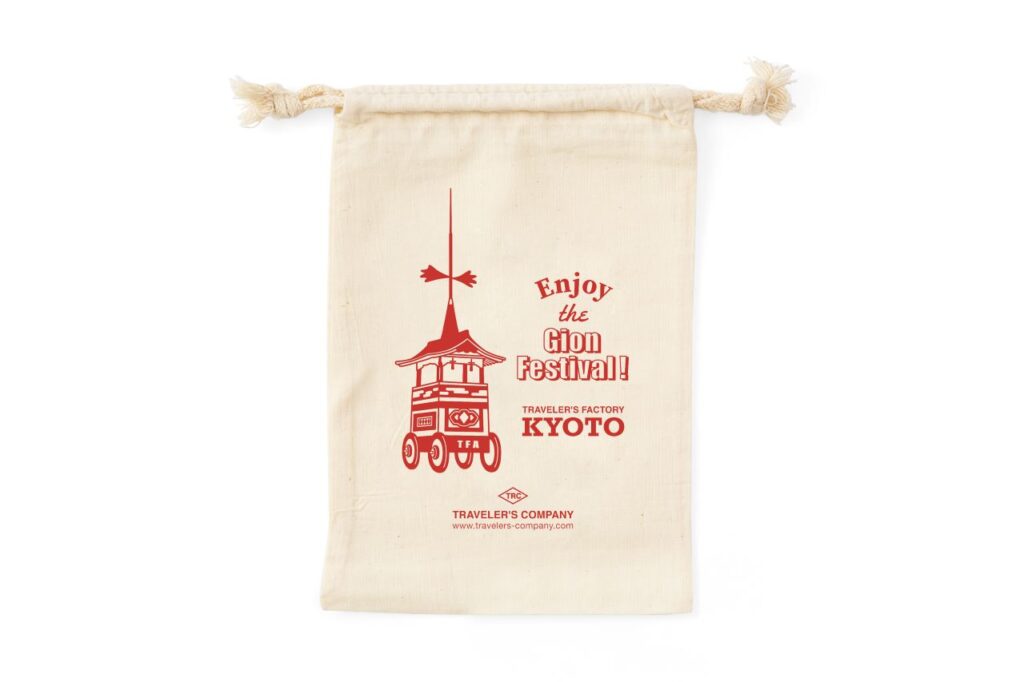
Cotton bag Gion Festival 550 yen; on sale from July 14 (Sun.) (until all gone)

Kyo Koma Jakkyu is the only workshop in Japan that carries on the tradition of Kyo Koma (Japanese comic strip). In 2005, it was designated as a traditional industry of Kyoto. The Kyo-koma Gion Yamaboko, which is in the shape of the Yamaboko floats of the Gion Festival, includes the Osafune in the photo, as well as the Choto-boko, Tsuki-boko, Mentoshi-boko, and other floats. Visitors can actually play with it by pinching and turning the bamboo shaft with their fingers.
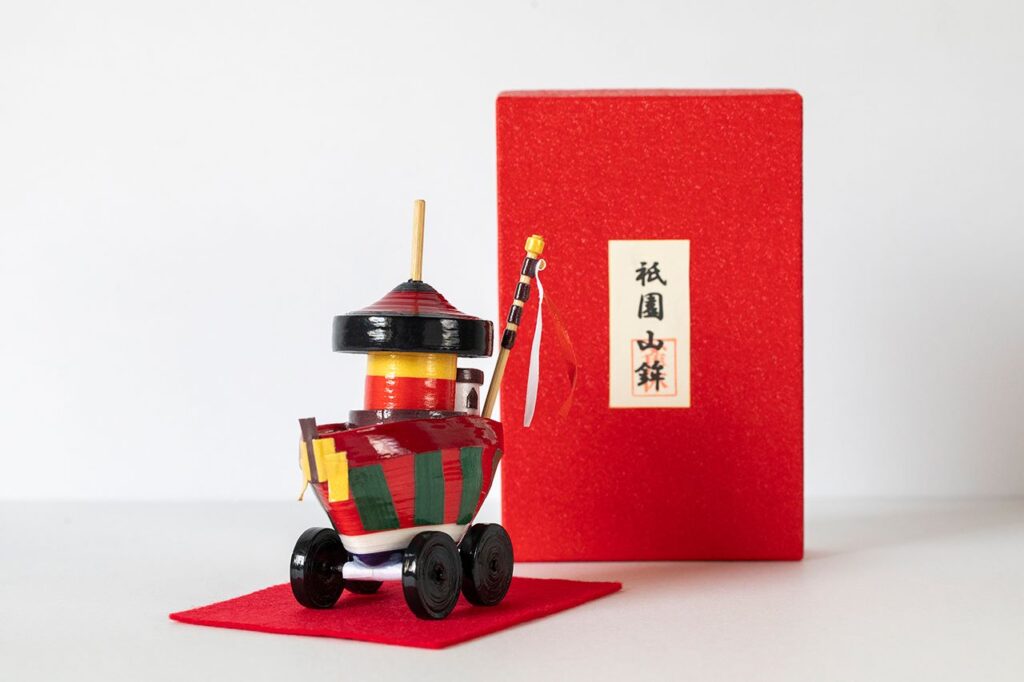
Photo shows Kyo-koma Gion Yamaboko O-fune, 5,500 yen. Sold all year round

Over 600 interviews per year! An order site carefully selected by the editors who knows Kyoto and Shiga.
nowOfficial LINE friend registration500 yen OFF coupon is being issued!
Distributed every Friday morning at 8:00 am! From new restaurant information to event information that we want to share with you, We deliver articles about Kyoto that are useful to know. About 20,000 people have registered.Click here to add a friend!
 News
News Feature article
Feature article Featured event
Featured event